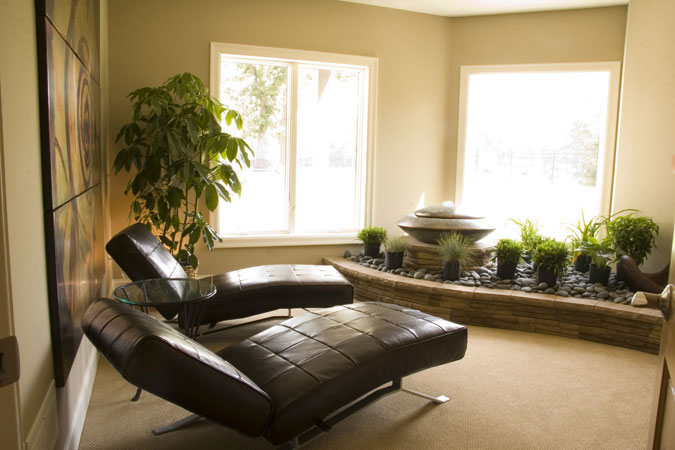In our daily fast-moving lives, we often neglect our well-being, self-care, and need for inner peace. One way to encourage yourself to practice self-care is to create a wellness space, a personal sanctuary, in your home.
In order for space to promote a sense of calm, relaxation, and well-being, I recommend you adhere by these three golden rules when you create it: 1. respect the laws of balance of interior design when designing a space, 2. apply some Feng Shui wisdom, and 3. add a few wellness aspects.
Respect the laws of balance when designing your space
Start by uncluttering the room or area you where you will create your wellness space. An uncluttered space has a calming effect.
Then think of what soothes you. Is it a trip to the spa? A long walk in nature? Why not use these as themes in your design, channeling those experiences in order to create a relaxing vibe in your space?
A Zen-inspired design with soft-toned natural colors, like white, grey, or shades of beige, have the power to induce a sense of relaxation and calmness. Chromatic harmony between the various elements of the space is important, as is the visual continuity between walls, furniture, and floors. Earthier colors or colors close to your skin color will create a soothing and relaxing subconscious feeling.
Ideally, your space has access to natural light, but if you must use lights, select indirect lightings such as dimmable side lamps, salt lamps, and candles.
Create a comfortable setting around your feet, you might use side cushions, throw pillows or carpets. You can reinforce the cocooning sensation of the room by using a pure wool or cotton carpet in a color that either matches the floor or is in the range of light colors such as khaki and grey. It is important that you are able to comfortably walk barefoot in your space, so that you may connect to the earth and ground yourself.
Some Feng Shui wisdom
In Feng Shui, the placement of furniture is generally limited to the perimeters of the room. A clear walking path brings peace to the room.
The placement of seats should have you not sit with your back to a room’s door. You should feel protected in your space opt for rounded and curved designs, avoid furniture with sharp corners or irregular shapes. Work to create a harmonious balance by, for example, placing two identical items on the same level in the room.
Small elements of detail in accessories placed in your space can also contribute to a peaceful atmosphere. Think of photos of peaceful and natural settings – such as a clear mountain stream or light shining through a thick forest -, or a few indoor plants. Keep these to a minimum, to keep the room uncluttered.
Wellness aspects:
Natural elements, including sunlight and fresh flowers, bring a sense of well-being to any space.
Ideally, your wellness space is in a quiet part of your house to avoid disturbance of Qi energy and keep you from becoming tense. Pleasant sounds such as that of water flowing in a tabletop fountain; or calm instrumental classical music can promote relaxation.
Fragrances can go a long way towards the creation of a calming and relaxing atmosphere. Pleasant scents such as those of lavender or vanilla essential oils create a sense of peace in the room (strong odors have the opposite effect), while Frankincense is known to be a powerful scent for meditation and relaxation.
Start simple, and steadily work to create a soothing and uplifting space for you to enjoy and enhance your well-being at home.

